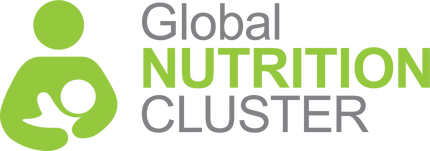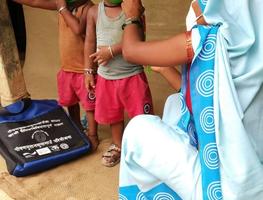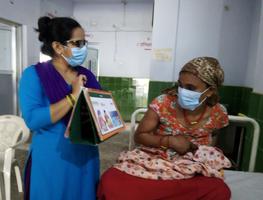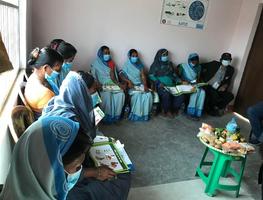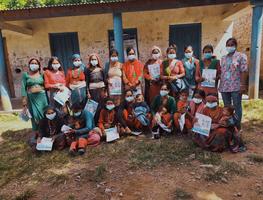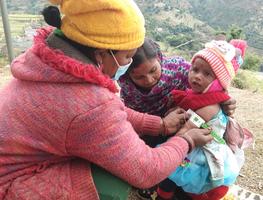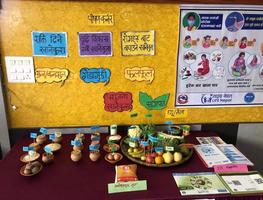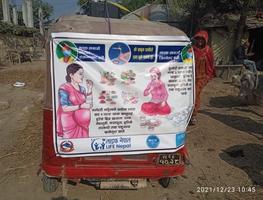Request support on coordination, information management, integration for nutrition outcomes or technical nutrition in emergencies assistance.
التماس الدعم لتنسيق التغذية وإدارة المعلومات والتغذية في حالات الطوارئ
Demander un appui pour la coordination de la nutrition, la gestion de l'information et la nutrition dans les situations d'urgence
Buscar apoyo para la coordinación de la nutrición, la gestión de la información y la nutrición en situaciones de emergencia
Solicite apoio para coordenação em nutrição, gestão de informação e nutrição em emergências
Nepal
OtherCoordination mechanism: Nutrition in emergency cluster coordination includes one federal nutrition cluster, 6 technical sub-working groups under NuTEC, 7 Provincial Nutrition clusters, Intercluster working groups led by Ministry of Home Affairs
Year of activation: The nutrition cluster was established and activated in June 2010 and Nutrition cluster at the provincial level was activated in May 2020.
Coordination arrangement:
National Nutrition Cluster:
• Lead: FWD/DoHS/MoHP
• Co-lead: UNICEF
• Information management: WFP
Provincial Nutrition Cluster:
• Lead: Provincial Health Director
• Co-lead: UNICEF
Mr Lila Bikram Thapa
Chief, Nutrition Section of MoHP (Nutrition Cluster Lead), Government of Nepal thapalila20@gmail.comMr Uttam Acharya
Nutrition Officer, WFP/Information Management Officer for the National Nutrition Cluster uttam.acharya@wfp.orgKey Content
highlights from
The State of Food Security and Nutrition in the World 2020
The state of Food Security and Nutrition in the World 2020 report was published by FAO, IFAD, UNICEF, WFP, and WHO. According to the report, almost 690 million people around the world went hungry in 2019. As progress in fighting hunger stalls, th
Read this newsAnnual Report 2023
January-December 2023
Nutrition Cluster Structure
Coordination mechanism:
Nutrition cluster coordination includes i) Inter-cluster coordination led by the National Disaster Risk Reduction and Management Authority (NDRRMA) within the Ministry of Home Affairs which is the overall lead agency for disaster coordination and management of the Government of Nepal. In this coordination arrangement, there is the participation of the cluster lead agencies (Government Ministries), co-lead agencies (UN agencies) and special invitees; and ii) humanitarian country team at principle and operation levels led by UN Residence Coordinator and in this coordination mechanism there is the participation of the concerned agency heads at principle levels and national cluster co-leads and special invitees at operation level from different 11 clusters.
In the case of the nutrition cluster, the nutrition section, family welfare Division, Department of Health Services under the Ministry of Health and Population (MoHP) has been leading the cluster coordination mechanism jointly with UNICEF as the co-lead. Also, the information management for the cluster is being supported by WFP.
There are six Technical Working Groups (TWG) under the national nutrition cluster which is providing technical assistance to the cluster partners and government to develop standards and guidance as well as technical assistance for nutrition interventions in a humanitarian context. The TWGs are:
1. Infant and Young Child Feeding in Emergency TWG
2. Integrated Management of Acute Malnutrition TWG
3. Micronutrient Deficiency Prevention and Control Intervention TWG
4. Behaviour Change Communication TWG
5. Information Management TWG
6. Nutrition Assessment TWG
These groups have chairs and members lead by different agencies who are the members of nutrition clusters with the overall guidance of nutrition cluster lead and co-lead. Apart from these 6 TWG, the is another one additional working group that provides technical assistance to develop/revise contingency plan as well as nutrition in emergency preparedness and response plan, cluster operating guideline etc.
There are Nutrition Clusters in all 7 provinces, one in each province, lead by Provincial Health Director and co-lead by UNICEF.
The provincial-level nutrition clusters are coordinating to the district and below levels.
Year of activation: The nutrition cluster was established in June 2010
The nutrition clusters at the provincial level were activated in April-May 2020.
Before June 2010, the nutrition cluster was joint with health as a health and nutrition working group and was led by WHO and UNICEF jointly with the Ministry of Health and Population (MoHP). After the Government endorsed the “National Disaster Response Framework” in 2013, concerned Government's Ministries started to provide cluster leadership. In case health and nutrition cluster, MoHP has been leading cluster coordination mechanism jointly with WHO for health cluster and with UNICEF for nutrition cluster.
Coordination arrangement:
National Nutrition Cluster:
• Lead: Nutrition Section, Family Welfare Division, Department of Health Service, MoHP
• Co-lead: UNICEF
• Information Management: WFP
Provincial Nutrition Cluster:
• Lead: Provincial Health Directorate
• Co-lead: UNICEF
Link to HNO 2021
Nepal is among the most multi-hazard prone countries in the world, According to Global Climate Risk Index 2019, Nepal ranks 4th in terms of the climate crisis and 11th in terms of global risk for earthquakes. and is in the top 20 in terms of all multi-hazards countries in the world flood risks. Besides, landslides and disease epidemics are also common hazards with increasing frequency every year, affecting the lives and livelihood of the people, hampering the economy and sustainable development, as well as human dignity and rights. For instance, in past 11 years, altogether 5,825 floods or landslides happened and from these events, 2,362 people were died, 880 disappeared, 61,432 houses were destroyed and approximately USD 150 million was economic loss.
The Hills and Mountains areas of Nepal are highly susceptible to landslides and debris flows, including those caused by landslide damming, excessive erosion of hill slopes and rockfalls. Meanwhile, the flat plains of the Terai are at high risk of flooding, which can be exacerbated by the large disposition of debris in riverbeds and by the construction of embankments across rivers. Flooding in Nepal mostly occurs during the monsoon season, between June and September, when 80 percent of the annual precipitation falls, coinciding with snowmelt in the mountains. Flash floods and bishyari (the breaking of natural dams caused by landslides) are common in the Mountains, whilst river flooding occurs when streams augmented by monsoon rains overflow in the Terai plains in the south of the country. These floods can go on to impact Uttar Pradesh, Bihar, and West Bengal states in India as well as Bangladesh.
- Approximately, more than 36 districts out of 77 are supposed to be vulnerable to landslides and floods. Some of the recent disasters in Nepal include:
- In April and May 2015, Nepal experienced an earthquake that caused major loss of life and damage, mainly across central and western regions of the country.
- In 2016, droughts affected the mid and far-western hills and mountains of the country
- In 2017, monsoon floods affected whole Terai areas affected 22 districts out of 77 of the country
- In 2018 and 2019 heavy flooding affected some districts of the Terai regions
- In 2020, the whole country was affected by COVID-19, and in the situation flood and landslides were also observed in many places of the country
- In 2021, the continuous rainfall across the country severely affected more than 45 districts in total that caused floods and landslides which resulted human casualties, displaced many people, damaged infrastructure, crops, and livestock. due to the landslides and floods, more than 100 people have lost their lives, 66 people are injured, more than 1,677 houses are affected (fully destroyed-748 and partially destroyed-929).
- On 31 July 2022, there was an earthquake in Khotang district of eastern Nepal affecting 136,669 population of 493 houses
- In 2022, nationwide, monsoon landslide and floods has been affected many people and so far, 40 people have been dead (28 men) and 9,349 families have been affected out of which 3,687 have been displaced.
- In November 2023, a magnitude of 5.7 earthquake struck Jajarkot and Rukum West districts of Karnali province killing 153 people.
Humanitarian Nutrition needs:
- 2.4 million children aged 6-59 months are in need of Vitamin A supplementation
- 906,331 children aged 6-23 months in need of Multiple Micro-nutrient powders
- 758,652 pregnant and lactating mothers need infant and young child feeding (IYCF) counseling across the country
- 20,000 children age 0-59 months with severe acute malnutrition (SAM) require therapeutic food
- 115,000 children 6-59 months get 85,000 pregnant and lactating mothers require super cereal for the prevention of acute malnutrition focusing 6-23 months
Work in coordination with various clusters like food security, health, protection, water and sanitation.
Counseling on a maternal, infant, and young child nutrition for pregnant and postnatal mothers. Prevention and control of unsolicited donations and distribution of breastmilk substitutes.
Publicize public awareness materials.
Mobilize all 7 provincial nutrition clusters, and carry out nutrition survey/assessment of 6-59 months children in a simplified manner through the local level, local health facilities and female health volunteers, and refer for treatment of severe and medium early malnutrition to the health facilities for OPD nutrition service or provide treatment by admitting to the nutrition rehabilitation home.
Distribute additional nutritious food to children between 6-23 months and 85,000 pregnant and lactating mothers in the floods affected areas.
Ensure essential supplies to keep the nutrition related structures up-to-date.
Administer Vitamin A capsules to children between 6-59 months in the floods affected areas. Administer deworming tablets to children of 12-59 months in the same area.
Distribute iron and folic acid tablets as per the policy following health check-up and nutrition consultation to Antenatal and Postnatal women in the flood affected areas.
- Expand outpatient management of acute malnutrition to health posts and via female community health volunteers, using adapted treatment protocols by using simplified approaches.
- Implement the simplified approach nationwide for the treatment of moderate and severe acute malnutrition by using RUTF.
- Provide multiple micro-nutrient powders to children aged 6-23 months.
- Build the capacity of health workers, female community health volunteers, mothers/caregivers of children 6-59 months for household-based active nutrition screening (family MUAC).
- Social behaviour changed communications through different media.
- Resource gaps to manage blanket supplementary feeding program (BSFP) to cover the children age 6-59 months and pregnant and lactating women in the most emergency affected and vulnerable locations.
- Resource gap to manage therapeutic feeding programme for the treatment of moderate and severe acute malnutrition by using simplified approaches
- lack of effective screening of the children 6-59 months (around 30% coverage of SAM every year)
- The limited operational capacity of government for preparedness response the nutrition issues in emergencies at provincial and local levels.
- Lack of effective reporting of the treatment of acute malnutrition in the HMIS
- Lack of required capacity of local levels for the management of development as well as development programme since all authorities have been given to the local levels in federal context.
Key Figures
(million)Funding
(million)- Children 6-59 months
- Pregnant and Lactating Women
Total Partners
